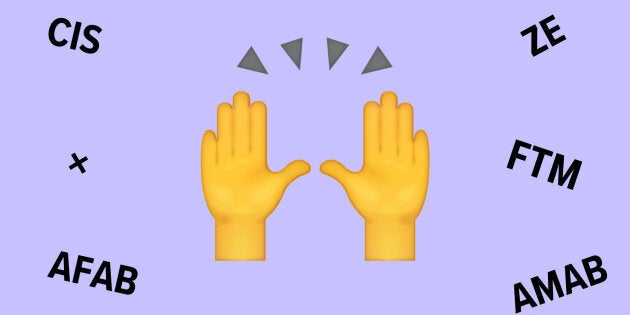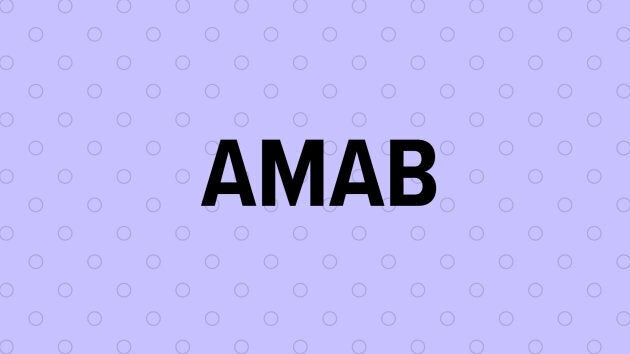
Regardless of their gender identity or sexual orientation, parents use the same acronyms online — everyone wants their LO to STTN!
But let's say you read, "FTM here — ISO resources to help my preschooler," and assume that this person is a "first time mom." Not so fast: it's also possible they could be transitioning "female to male" and are in search of resources to help their kid understand.
Digital parenting groups can be a life-saver for new parents seeking to connect with others, ask questions, and vent — and they often have their own language. But for LGBTQ parents, these groups can be "a double-edged sword," Kiersten Mohr, President of the Airdrie Pride Society, told HuffPost Canada.
"You can get negativity and judgment in an environment where that's the last thing you need; as a parent, you need non-judgment and understanding."
WATCH: Learn the right LGBTQ terminology. Story continues below.
Being comfortable with the language of sexual and gender diversity can go a long way — even those within the LGBTQ community need refreshers sometimes. But it's also important to do one's own research — and not assume that just because someone identifies as LGBTQ they want to be a full-time diversity educator.
Mohr told an illustrative story about a mother and her trans child: "Initially, when the child first began their transition, they would explain what is sex, what is gender, to everyone they met. The mom said she got tired of it, and eventually just wanted to put a name tag on that said, 'Google It'."
Ash Hardell, an LGBT+ educator and the author of The ABCs of LGBT, told HuffPost Canada that the language of inclusion "can be complicated, it can be hot-button, there can be a lot of feelings. But ... it doesn't have to be scary, it can be exciting. It's an opportunity to see a different worldview."
Hardell would love those who are reading this very brief list, or their much more thorough book, to know "how empowering language can be, and how validating it can be. If a word exists to describe you, or a part of your identity, that means that other people like you exist — you're not an outsider, you're not broken. It can give you a sense of community."
Now that you know why you should bone up, here's a list of some common LGBTQ and sexual and diversity terms used online.
A brief guide to gender and sexual diversity terms for parents

When you post on your local FB parenting group that you're a WAHM who's LF productivity tips, and someone says, "OMG, samesies! My AFAB isn't letting me get any work done today," get Googling (or just reference this list).
And remember: one way to be inclusive and kind online is to add your pronouns on the next parenting group introduction thread. It's as easy as, "Hi, I'm Bri (she/ her), and I am trying to remain sane while parenting a 2 y/o AFAB and a 4 y/o AMAB. Please send coffee."
AMAB/AFAB: Assigned female/male at birth. Many parents choose to identify their children this way, as it doesn't assume that their biological sex corresponds their gender. UAAB is "unassigned at birth," often used by parents who are raising their children as gender-open.
Chestfeeding: This term is more inclusive of trans, non-binary, and gender non-conforming parents who are nursing or looking for lactation support. Here's a great blog for more on this.
Cis/trans: While these sound like acronyms, they're actually abbreviations. "Cisgender" is someone whose biological sex matches their gender ("cis" is Latin for "on the same side as"). "Transgender" is an umbrella term for those who either don't identify as the gender they were assigned at birth, or who don't conform to the stereotypical expectations of their gender. Non-binary refers to individuals who don't define as either male or female; they often use pronouns like they/ them, ze/zer, etc., and they may or may not also identify as trans.
FTM/MTF: Sometimes used to indicate a person who is either transitioning from female to male, or vice versa — or who identifies as female/ feminine or male/ masculine, but wasn't assigned as such at birth. Some trans folks choose not to use these terms, as they don't support the idea that they have always been the gender they are.

Gender: "We're having a gender reveal party!" If you listen closely, you can hear the LGBTQ community cringe every time this festivity is so misnamed (unless your child is 20-years old and trans — then, it is fabulous). Gender is a subjective cluster of traits, stereotypes, and societal expectations that can shift over time and across cultures (so, no — your baby actually doesn't have a subjective understanding of their own gender yet). Science is coming to understand that gender is not determined by our body parts, and exists on a spectrum.
GNC: Gender non-conforming. Also called genderqueer, gender variant, or gender creative. People who don't identify as the biological sex they were assigned at birth, and/or who may not conform to societal expectations of their gender. GNC individuals may or may not identify as trans. (As a parenting choice, gender creative may also refer to those who choose to raise their kids without a gender until they're old enough to form a subjective sense of self).
LGBTQ2S+: Ah, the acronym. Whatever you do, please don't make a joke about alphabet soup — it won't go down well. That said, it's completely understandable to feel bewildered, as there are many identities and orientations that go into the variations on the LGBTQ acronym. If you'd like to know more about each of the terms below, Toronto's The 519 has produced a user-friendly glossary to help you.
- L: Lesbian
- G: Gay
- B: Bisexual
- T: Transgender or transsexual
- I: Intersex
- Q: Queer
- Q: Questioning
- A: Asexual, aromantic, or allied
- 2: Two-spirited
- P: Panssexual
- + : Everyone else!
More from HuffPost Canada:
OH (Other half) and SO (Significant other): These are both gender-neutral labels for one's partner. Even if you're paired up with someone of the opposite sex, you can mess with the system and use language like "partner" so others are kept on their toes and don't assume heterosexuality by default (that's also called "heteronormativity," FYI). And remember — just because a woman is in a same-sex relationship, doesn't mean she is a lesbian, for example. The only way to know someone's orientation is if they tell you.
Sex: No, not like the thing leads some people to parenting groups to begin with. The relationship between sex and gender is complex, but crucial to understand. Sex is the reproductive bits, the biological aspects, and the genetics that have been chosen to signify "male," "female," or "intersex."
Also on HuffPost: